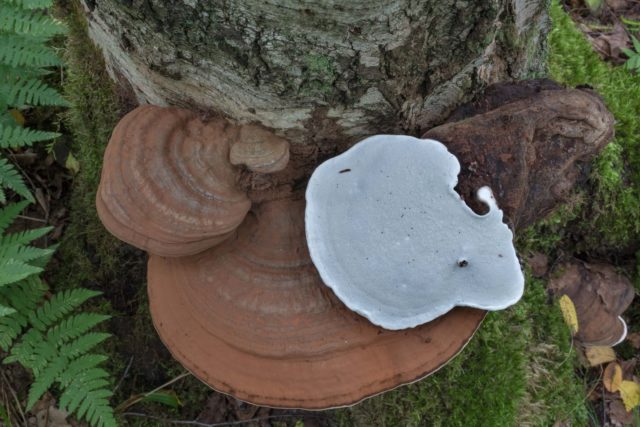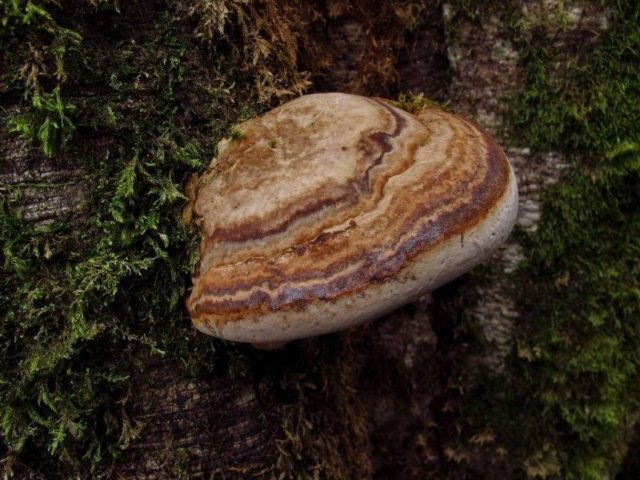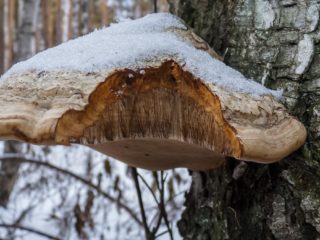Content
The flat fungus (Ganoderma applanatum or lipsiense), also called the artist's mushroom, belongs to the family Polyporaceae and the genus Ganoderma. This is a classic example of a perennial tree fungus.
Scientific names given to the fruiting body by different mycologists:
- first described and classified as Boletus applanatus by Christian Person in 1799;
- Polyporus applanatus, 1833;
- Fomes applanatus, 1849;
- Placodes applanatus, 1886;
- Phaeoporus applanatus, 1888;
- Elfvingia applanata, 1889;
- Ganoderma leucophaeum, 1889;
- Ganoderma flabelliforme Murrill, 1903;
- Ganoderma megaloma, 1912;
- Ganoderma incrassatum, 1915;
- Friesia applanata, 1916;
- Friesia vegeta, 1916;
- Ganoderma gelsicola, 1916

The mushroom grows in one place for many years, reaching gigantic sizes.
Description of the flat polypore
The mushroom cap is fleshy, sessile, and adheres to the substrate with its flat side. Prostrate-rounded, tongue- or petal-shaped, hoof-shaped or disc-shaped. The surface is usually flat, with straight or raised edges. It has concentric scars-strips diverging from the place of growth, and may be slightly folded or wavy. Reaches 40-70 cm in diameter and thickness at the base up to 15 cm.
The surface is dense, matte, slightly rough. The color can be different: from gray-silver and creamy beige to chocolate and brown-black. Sometimes overgrown mushrooms take on bright burgundy-red shades. The leg is absent even in its infancy.
The spores are rusty-brown in color and often cover the top of the mushroom with a kind of powdery coating. The edge is rounded, thin in young specimens, and white. The spongy undersurface is white, creamy silver or light beige. The slightest pressure causes it to darken to a grey-brown color.

The fruiting bodies are arranged in small close groups, forming a kind of canopy
Where and how does it grow
The flat tinder fungus is common in temperate and northern latitudes: in Russia, the Far East, Europe and North America. Active growth begins in May and continues until September.You can see the mushroom at any time of the year, even in winter frosts, if you remove the snow from the tree.
This tree parasite lives mainly on deciduous trees. It can take a liking to both living damaged trees and dead wood, stumps, dead wood and fallen trunks.

The flat tinder fungus does not climb high; it usually settles at the very roots or in the lower part of the tree
Doubles and their differences
The unique appearance and stunning size eliminate any confusion in the definition of the flat tinder fungus. There are some similarities with several species.
Varnished tinder fungus. Inedible. It is distinguished by a waxy cap and smaller size.

Lacquered polypore is widely used in Chinese folk medicine.
Southern tinder fungus. Inedible, non-toxic. It is distinguished by its large size and glossy surface.

Its edge, unlike the flat tinder fungus, is gray-brown
Is the mushroom edible or not?
The flat tinder fungus (Ganoderma applanatum) is classified as an inedible mushroom. It has hard, corky pulp that has neither taste nor smell, which reduces its culinary value.
Medicinal properties of flat tinder fungus
Being essentially a parasite that destroys trees, the flat polypore is widely used in folk medicine in a number of countries. It is especially valued in China. Its beneficial properties:
- improves immunity and fights viral diseases;
- normalizes blood pressure, reduces acidity levels in the gastrointestinal tract;
- relieves inflammatory processes in joints and internal organs, having a beneficial effect on rheumatic pain, asthma, bronchitis;
- normalizes blood sugar and promotes insulin production;
- improves the condition of the nervous system, has an anti-allergenic effect;
- It is a good remedy for the prevention of cancer and neoplasms, and it is also useful to take it as part of a complex treatment of tumors.
The use of flat tinder fungus in folk medicine
Alcohol tinctures, decoctions, powders, and extracts are made from Ganoderma oblates. Used for pulmonary diseases, diabetes, inflammatory processes and oncology. To increase immunity and improve the functioning of the cardiovascular system, healthy tea is prepared from the fruiting body.
The collected fruiting bodies must be dried at a temperature of 50-70 degrees and ground into powder. Store in a dry, hermetically sealed container out of direct sunlight. Tea made from polypore (Ganoderma applanatum)
Required ingredients:
- mushroom powder – 4 tbsp. l.;
- water – 0.7 l.
Pour water over the powder, bring to a boil and cook over low heat for 5-10 minutes. Pour into a thermos, close and leave for half a day. Tea can be taken 3 times a day, 40-60 minutes before meals, 2 tbsp. l. The course of treatment is 21 days, after which you should take a week break.
This tea is effective in removing toxic substances from the body and stimulating the digestive system.
Some interesting facts
This fruiting body has several unique features:
- A flat cut polypore applied to the wound promotes rapid healing and tissue regeneration.
- Over the course of several years, the flat tinder fungus can reach enormous sizes, while the light surface of the geminophore remains rounded, even and smooth.
- Young flat polypores can germinate on the body of an old mushroom, creating bizarre structures.
- Craftsmen create stunning paintings on the internal porous surface of large specimens. For this, a match, thin stick or rod is enough.
Conclusion
The flat tinder fungus is a widespread mushroom in the Northern Hemisphere. It has healing properties and is used in Chinese folk medicine. There are references to treatment with its help in Ancient Greek sources, in particular, the healer Dioscorides recommended it as an excellent remedy for cleansing the body and nervous disorders. It can be found in deciduous forests, on lying trunks, stumps and dead wood. It is unsuitable for food due to its hard, tasteless pulp. He has no poisonous counterparts. Some types of polypores have common features, but it is difficult to confuse them.









